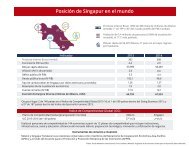basic-guide-to-exporting_Latest_eg_main_086196
basic-guide-to-exporting_Latest_eg_main_086196
basic-guide-to-exporting_Latest_eg_main_086196
You also want an ePaper? Increase the reach of your titles
YUMPU automatically turns print PDFs into web optimized ePapers that Google loves.
product may have the same ex-fac<strong>to</strong>ry price as a domestic product, its final consumer price maybe considerably higher once <strong>exporting</strong> costs have been included.Marginal cost pricing is a more competitive method of pricing a product for market entry. Thismethod considers the direct out-of-pocket expenses of producing and selling products for exportas a floor beneath which prices cannot be set without incurring a loss. For example, additionalcosts may occur because of product modification for the export market <strong>to</strong> accommodatedifferent sizes, electrical systems, or labels. Costs may decrease, however, if the export productsare stripped-down versions or made without increasing the fixed costs of domestic production.Many costs that apply only <strong>to</strong> domestic production, such as domestic labeling, packaging, andadvertising costs, are subtracted, as are costs such as research and development expenses if suchcost would have been incurred anyway for domestic production.Other costs should be assessed for domestic and export products according <strong>to</strong> how much benefiteach product receives from such expenditures, and may include:• Fees for market research and credit checks• Business travel expenses• International postage and telephone rates• Translation costs• Commissions, training charges, andother costs associated with foreignrepresentatives• Consultant and freight forwarder fees• Product modification and specialpackaging costsAfter the actual cost of the export product has been calculated, you should formulate anapproximate consumer price for the foreign market.Market DemandFor most consumer goods, per capita income is a good gauge of a market’s ability <strong>to</strong> pay. Someproducts create such a strong demand (e.g., Levi’s denim jeans) that even low per capita incomewill not affect their selling price. Simplifying the product <strong>to</strong> reduce its selling price may be ananswer for your company in markets with low per capita income.Your company must also keep in mind that currency fluctuationsmay alter the affordability of its goods. Thus, pricing should try <strong>to</strong>accommodate wild changes in the valuation of U.S. and foreigncurrencies. A relatively weak dollar makes the price of U.S. goodsmore competitive in many markets around the world, therebyenabling you <strong>to</strong> compete with domestic producers as well as withother foreign competi<strong>to</strong>rs whose production costs are suddenlyreflected in their inflated domestic currencies. Your company shouldalso anticipate the kind of cus<strong>to</strong>mers who will buy your product. Ifyour company’s primary cus<strong>to</strong>mers in a developing country are eitherexpatriates or local people with high incomes, a higher price mightbe feasible even if the average per capita income is low.Pricing information can becollected in several ways.Overseas distribu<strong>to</strong>rs andagents of similar productsof equivalent quality areone source. Also, traveling<strong>to</strong> the country where yourproducts will be sold providesan excellent opportunity <strong>to</strong>gather pricing information.Chapter 13: Pricing, Quotations, and Terms149





